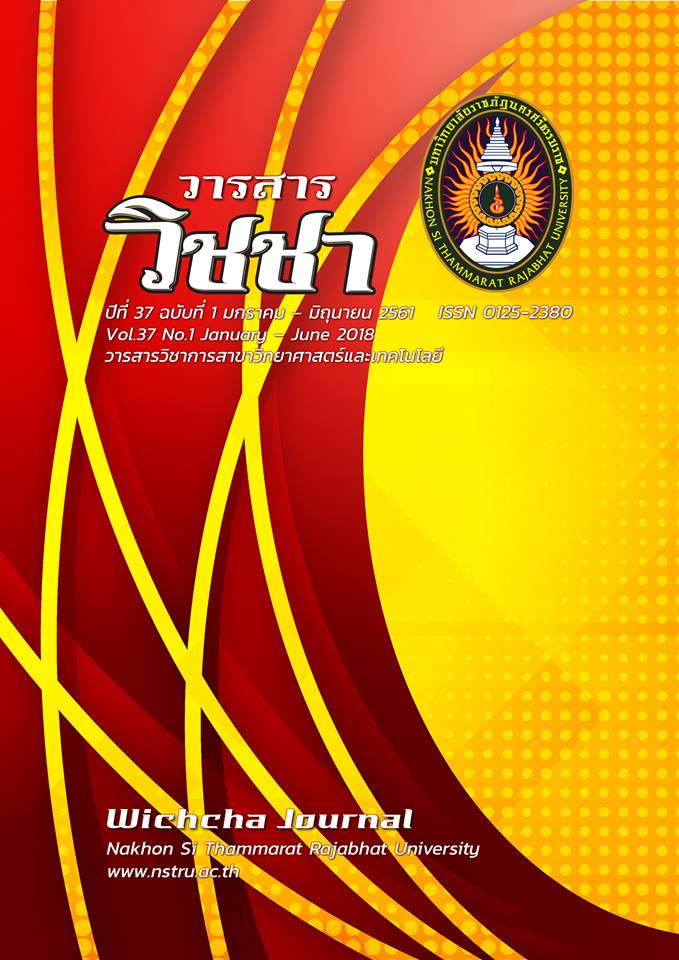การศึกษาเถ้าปาล์มน้ำมันเพื่อผลิตแผ่นคอนกรีตปูพื้นทางเท้า
Main Article Content
Abstract
The object of this research was to determine the effects of palm oil fuel ash as cement substitution on flooring paving slabs (size 11.3 × 19.5 × 6.0 cm.) properties. The palm oil fuel ash is a byproduct from palm oil industry. The experiment consisted of 6 treatments which were different palm oil fuel ash ration: 0, 10, 20, 30, 40 and 50 percent by weight. The results showed that properties of cement flooring paving slabs e.g. size and weight of all rations were similar. Water absorption percentage of the palm oil fuel ash concrete mixtures were higher. The results showed that the replacing cement with palm oil fuel ash content decrease the cost of cement flooring paving slabs. When replacing cement with palm oil ash at a ratio of 10 percent the cost of production was that of using cement alone.
Article Details
เนื้อหาและข้อมูลในบทความที่ลงตีพิมพ์ในวารสารวิชชา มหาวิทยาลัยราชภัฏนครศรีธรรมราช ถือเป็นข้อคิดเห็นและความรับผิดชอบของผู้เขียนบทความโดยตรง ซึ่งกองบรรณาธิการวารสารไม่จำเป็นต้องเห็นด้วยหรือร่วมรับผิดชอบใด ๆ
บทความ ข้อมูล เนื้อหา รูปภาพ ฯลฯ ที่ได้รับการตีพิมพ์ในวารสารวิชชา มหาวิทยาลัยราชภัฏนครศรีธรรมราช ถือเป็นลิขสิทธ์ของวารสารวิชชา มหาวิทยาลัยราชภัฏนครศรีธรรมราช หากบุคคลหรือหน่วยงานใดต้องการนำข้อมูลทั้งหมดหรือส่วนหนึ่งส่วนใดไปเผยแพร่ต่อหรือเพื่อการกระทำการใด ๆ จะต้องได้รับอนุญาตเป็นลายลักษณ์อักษรจากวารสารวิชชา มหาวิทยาลัยราชภัฏนครศรีธรรมราชก่อนเท่านั้น
The content and information in the article published in Wichcha journal Nakhon Si Thammarat Rajabhat University, It is the opinion and responsibility of the author of the article. The editorial journals do not need to agree. Or share any responsibility.
References
ธนกาญจน์ สำเภาลอย. (2559). ทดสอบการหาค่าการยุบตัวของคอนกรีต. ค้นเมื่อ 15 ธันวาคม 2559, จาก: http://mixdesign.cmtc.ac.th/project10/index.html.
ปิญชาน์ ต่อกิตติกุล. (2551). การพัฒนาคอนกรีตต้นทุนต่ำและพลังงานต่ำจากวัสดุผลพลอยได้และวัสดุเหลือใช้. วิทยานิพนธ์วิทยาศาสตรมหาบัณฑิต สาขาวิชาวัสดุศาสตร์ คณะวิทยาศาสตร์ มหาวิทยาลัยเชียงใหม่, เชียงใหม่.
พงษ์วิภา หล่อสมบูรณ์ อธิวัตร จิรจริยาเวช วัชรพงษ์ ศิลาเลิศรักษา และวุฒิพงษ์ ปรีดาภัทรพงษ์. (2548). การจัดทำฐานข้อมูล การประเมินวัฎจักรชีวิตการผลิตปูนซีเมนต์และเหล็กกล้าเพื่อการจัดการสิ่งแวดล้อม. กรุงเทพฯ: สำนักงานกองทุนสนับสนุนการวิจัย.
มาตรฐานผลิตภัณฑ์อุตสาหกรรม มอก.827-2531. (2531). คอนกรีตบล็อกประสานปูพื้น. ค้นเมื่อ 5ตุลาคม 2560, จาก: https://www.nqi.go.th/nqi/standard.php?item=1244.
ลดาวัลย์ สินสุพรรณ์ วริญญา ใจใส และทิพนภา ทองโชติ. (2556). เถ้าปาล์มน้ำมันเถ้าชานอ้อย และวัสดุปอซโซลานชนิดอื่น. วิทยาศาสตรบัณฑิต สาขาวิศวกรรมโยธา คณะวิศวกรรมศาสตร์ มหาวิทยาลัยมหาสารคาม, มหาสารคาม.
วีรชาติ ตั้งจิรภัทร จตุพล ตั้งปกาศิต ศักดิ์สินธุ์ แววคุ้ม และชัย จาตุรพิทักษ์กุล. (2546). วัสดุปอซโซลานชนิดใหม่จากเถ้าปาล์มน้ำมัน. วารสารวิจัยและพัฒนา มจธ., 26(4), 459-479.
แสงอรุณวัสดุการก่อสร้าง. (2552). การผลิตคอนกรีตผสมเสร็จ. ค้นเมื่อ 5 ตุลาคม 2560, จาก: http: //www.sangaroon.com/index.php?lite=article&qid=324000.
Chavlaparit, O., Rulkens, W. H., Mol, A. P. J., & Khaodhair, S. (2006). Options for environmental sustainability of the crude palm oil Industry in Thailand though enhancement of industrial ecosystems. Environment, Development and Sustainability. 8(2), 271-287.
Hussin, M. W., & Awal, A. S. M. A. (1996). Palm oil fuel ash - a potential pozzolanic material in concrete construction. In Proceedings of the International Conference on Urban Engineering in Asian Cities in the 21st Century 20-23 November 1996 (pp. D.361-D.366) Bangkok, Thailand.


